
Follow Your Strategy
This stock trading question comes from Gregg O. whose #1 challenge is…
“My challenge is following my strategy and taking a buy signal in the ASX after a large fall in the US the prior night”
A very good question. We’ve been programmed to expect Australia will follow on from any move in the US so this is worth investigating. To start with let’s take a quick look at the relationship between the US moves and Australia over the last 25-years. In the S&P 500 during this time there have been 2,948 down days (45%), 3390 up days (51%) with the balance (4%) being no change or public holidays. No surprises here.
So, of the 2948 down days, how often does Australia follow? Answer: 63.7% of the time.
In other words there is a 36.3% chance that the ASX will actually trade higher even though the US was negative. We could investigate more and define with the size of the falls in the US, but that’s beyond the scope of this discussion.
Back to the original question – should I follow my buy signal if the US has a down session? The technical answer is this; If the strategy you’re following does not contain a rule based on the prior move in the US, then yes, you should take the signal regardless. In this instance the move in the US is nothing but noise and when following a systematic approach you follow the rules and ignore the noise.
If the strategy did have a rule, such as, “…if the US market closes lower, do not take any buy signals”, then that would be your guidance.
Psychologically it can be a hurdle, but there are two things to remember. Firstly, there is a reasonable chance that the opening price will automatically take into account a fall in the US. The market is very efficient in this respect so the thought process of one immediately having a losing position because you bought on the open is not accurate. Indeed, some mean reversion strategies will use this opening weakness to initiate long-side trades.
Secondly, so what if you’re wrong? So what if the decline in the US market signals the start of a deeper decline for the Australian market? That’s what your stop loss is for. Your strategy has been tested (well, at least it should have been!) through many different market events, including these, and has supposedly fared well. Instead of attempting to micro manage the position based on a single and random event, you should be looking at the bigger picture, i.e. the next 1000 trades.
In summary, there is no point having a rule-based approach if you can’t follow the rules!


